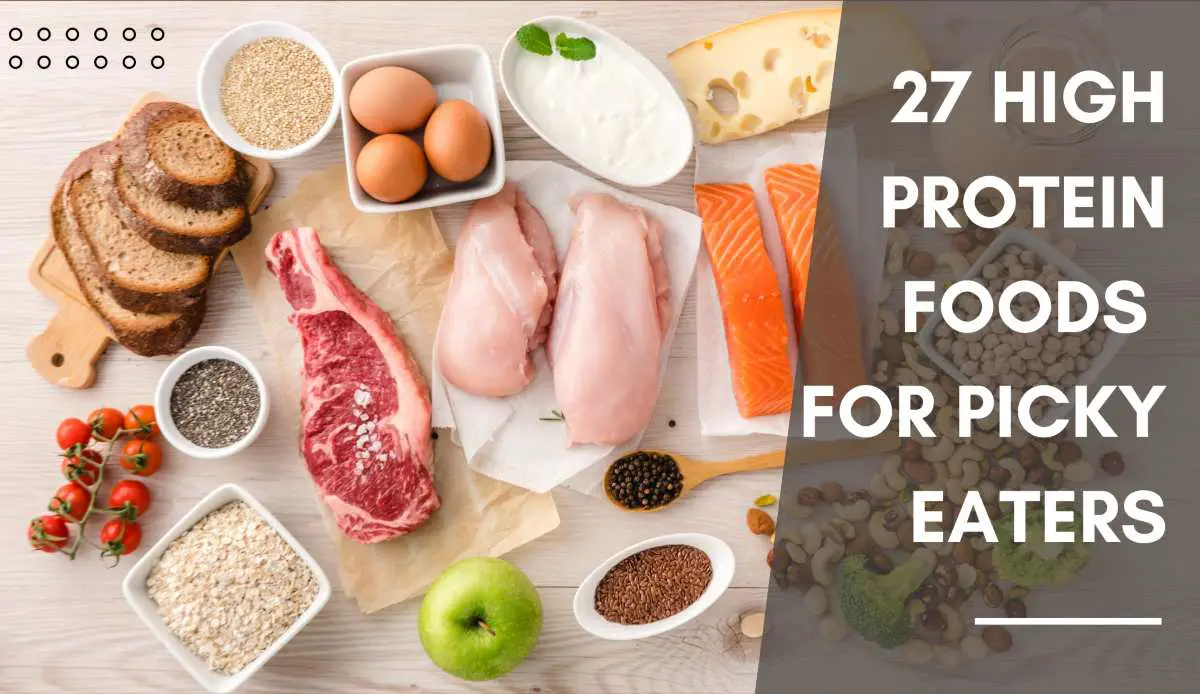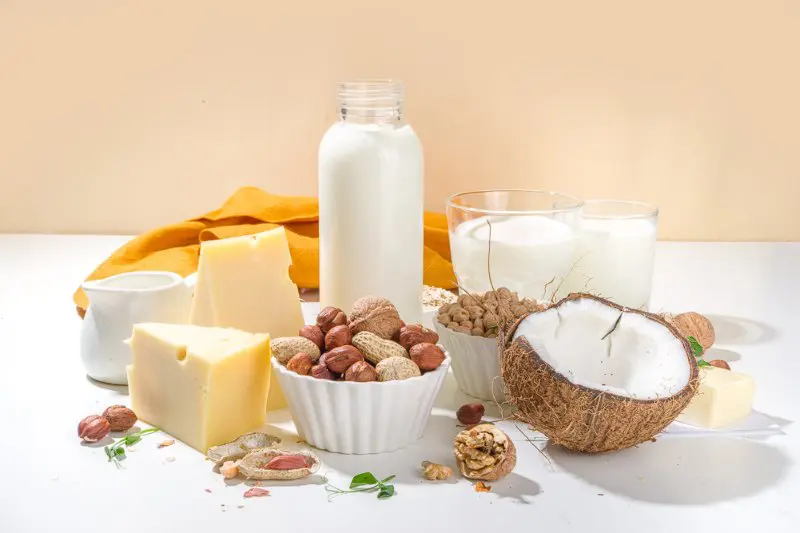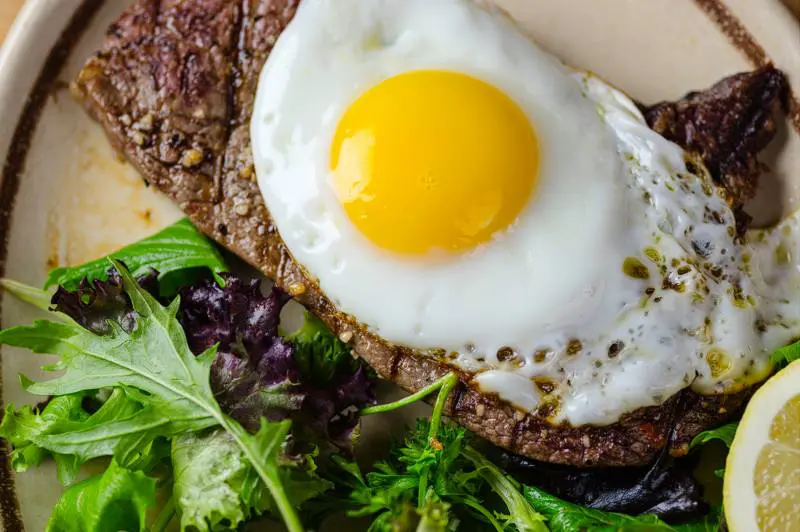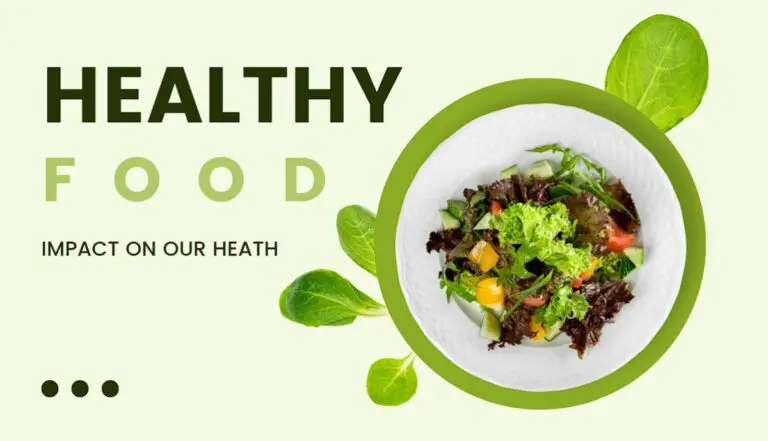Top 27 High Protein Foods For Picky Eaters

Introduction
A. Understanding Picky Eaters:
High Protein Foods For Picky Eaters: Picky eaters, also referred to as selective eaters, are individuals who exhibit a discerning or limited approach to food consumption. This behavior is characterized by a preference for specific tastes, textures, or appearances of food items, while often displaying aversion or reluctance towards others. Picky eating tendencies can emerge in early childhood and persist into adulthood, impacting dietary habits and nutritional intake.
The reasons behind picky eating behaviors are multifaceted and can vary widely among individuals. Sensory sensitivities, including heightened responses to taste, smell, texture, or appearance, may contribute to selective eating patterns. Additionally, past negative experiences with certain foods, such as unpleasant tastes or reactions, can influence food preferences and aversions. Psychological factors, such as anxiety or control issues related to food, may also play a role in picky eating habits.
Understanding the complexity of picky eating behaviors is crucial for devising effective strategies to address nutritional deficiencies and promote healthier eating habits. While picky eating itself is not necessarily a cause for concern, prolonged or severe selective eating patterns can potentially lead to inadequate nutrient intake and nutritional imbalances, which may impact overall health and well-being.
B. Importance of High-Protein Foods:
Protein is an essential macronutrient that serves as a fundamental building block for various tissues and organs in the body. Comprised of amino acids, protein plays a critical role in supporting muscle growth and repair, immune function, hormone production, and enzyme activity. Consuming an adequate amount of protein is particularly important for individuals of all ages, including picky eaters, to ensure proper growth, development, and maintenance of bodily functions.
For picky eaters, who may have limited dietary choices and preferences, incorporating high-protein foods into their meals is essential for meeting their nutritional needs. Protein-rich foods provide a source of sustained energy, promote feelings of satiety and fullness, and contribute to overall dietary balance. Moreover, protein consumption can help preserve lean muscle mass, especially when combined with regular physical activity, and support weight management goals.
Including a variety of high-protein foods in the diet can help picky eaters diversify their nutrient intake and overcome potential deficiencies associated with selective eating habits. By offering a range of protein sources with different flavors, textures, and culinary preparations, individuals can expand their palate and develop a more balanced approach to nutrition. [High Protein Foods For Picky Eaters]
C. Purpose of the Article:
The primary objective of this article is to offer a comprehensive guide to high-protein foods that are suitable for picky eaters. By presenting a curated list of protein-rich options accompanied by detailed descriptions, nutritional profiles, and serving suggestions, this article aims to empower individuals with selective eating habits to make informed dietary choices. Additionally, by highlighting the benefits of consuming high-protein foods, such as improved satiety, muscle support, and overall health promotion, this article seeks to underscore the importance of prioritizing protein-rich options in the diet.
Through practical tips, recipe ideas, and meal planning strategies tailored to picky eaters, this article endeavors to provide actionable insights for enhancing nutritional intake and promoting a more varied and balanced diet. By addressing the unique challenges faced by picky eaters and offering solutions to overcome dietary limitations, this article strives to promote health and well-being for individuals of all ages and dietary preferences. [High Protein Foods For Picky Eaters]
Table of Contents
27 High Protein Foods For Picky Eaters
Meat-based Proteins
1. Grilled Chicken Breast:
Grilled chicken breast is a versatile and nutritious protein option that is suitable for picky eaters. It is lean, low in fat, and rich in high-quality protein, making it an excellent choice for those looking to boost their protein intake without excess calories. Grilling chicken breast helps retain its natural juices and flavors while imparting a delicious smoky char.
To prepare grilled chicken breast, start by marinating the chicken in your favorite seasonings or marinades for added flavor. Common marinade ingredients include olive oil, garlic, lemon juice, herbs, and spices. Allow the chicken to marinate for at least 30 minutes to enhance its flavor profile. Then, preheat your grill to medium-high heat and cook the chicken breast for about 6-8 minutes per side, or until it reaches an internal temperature of 165°F (75°C). Let the chicken rest for a few minutes before slicing & serving.
Grilled chicken breast can be enjoyed on its own as a main dish or incorporated into salads, sandwiches, wraps, and stir-fries for added protein and flavor. It pairs well with a variety of side dishes, such as steamed vegetables, quinoa, brown rice, or roasted potatoes, to create a balanced and satisfying meal. [High Protein Foods For Picky Eaters]
2. Turkey Meatballs:
Turkey meatballs are a tasty and nutritious alternative to traditional beef meatballs, making them an ideal protein option for picky eaters. They are lower in fat and calories compared to beef, while still providing ample protein and flavor. Turkey meatballs can be easily customized with different seasonings, herbs, and spices to suit individual preferences.
To make turkey meatballs, start by combining ground turkey with breadcrumbs, egg, minced garlic, grated Parmesan cheese, and your choice of herbs and spices in a mixing bowl. Mix until well combined, then shape the mixture into small meatballs using your hands. Place the meatballs on a baking sheet lined with parchment paper and bake in a preheated oven at 375°F (190°C) for 20-25 minutes, or until cooked through.
Turkey meatballs can be served with marinara sauce and pasta for a classic Italian-inspired dish, or paired with a tangy barbecue sauce for a flavorful twist. They can also be added to soups, stews, and sandwiches for added protein and texture. Turkey meatballs are a convenient and delicious protein option that can be enjoyed in a variety of ways. [High Protein Foods For Picky Eaters]
3. Lean Beef Jerky:
Lean beef jerky is a portable and shelf-stable protein snack that is perfect for on-the-go consumption. It is made from lean cuts of beef that are marinated, seasoned, and then dried or smoked to create a flavorful and chewy texture. Beef jerky is rich in protein, low in fat, and free from added sugars and preservatives, making it a nutritious option for picky eaters.
When choosing beef jerky, opt for varieties that are made from lean cuts of beef and have minimal added ingredients. Look for options that are low in sodium and free from artificial flavors, colors, and additives. Beef jerky is available in a variety of flavors, including original, teriyaki, peppered, and spicy, allowing picky eaters to find a flavor that suits their taste preferences.
Lean beef jerky can be enjoyed as a standalone snack or paired with nuts, seeds, and dried fruit for a satisfying and nutrient-rich snack mix. It can also be added to salads, trail mix, or homemade snack bars for added protein and flavor. Beef jerky is a convenient and portable protein option that can help picky eaters meet their nutritional needs while on the go. [High Protein Foods For Picky Eaters]
4. Salmon Fillets:
Salmon fillets are a delicious and nutritious source of protein that is rich in heart-healthy omega-3 fatty acids. They are mild in flavor and have a tender and flaky texture, making them a versatile option for picky eaters. Salmon fillets can be prepared using a variety of cooking methods, including baking, grilling, broiling, or pan-searing.
To cook salmon fillets, start by seasoning the fillets with salt, pepper, and your choice of herbs and spices. Heat a non-stick skillet or grill pan over medium heat and lightly coat with olive oil or cooking spray. Place the salmon fillets skin-side down in the skillet and cook for 3-4 minutes, or until the skin is crispy and golden brown. Flip the fillets and continue cooking for an additional 3-4 minutes, or until the salmon is opaque and flakes easily with a fork.
Salmon fillets can be served with a squeeze of fresh lemon juice and a sprinkle of chopped herbs for a simple and elegant presentation. They can also be paired with a variety of sauces, such as teriyaki glaze, honey mustard, or dill yogurt sauce, to add extra flavor and moisture. Salmon fillets are a nutritious and delicious protein option that can be enjoyed as a main dish or incorporated into salads, wraps, and pasta dishes for added protein and omega-3s. [High Protein Foods For Picky Eaters]
Plant-based Proteins
5. Tofu Varieties:
Tofu, also known as bean curd, is a versatile and nutritious plant-based protein made from soybeans. It is a staple ingredient in many cuisines, particularly in Asian dishes, and comes in various textures, including silken, soft, firm, and extra-firm. Tofu is an excellent source of protein, iron, calcium, and other essential nutrients, making it an ideal option for picky eaters seeking plant-based protein alternatives.
Tofu can be prepared in numerous ways to suit different tastes and preferences. It can be marinated, grilled, baked, stir-fried, or used as a substitute for dairy in smoothies, desserts, and creamy sauces. Silken tofu is commonly used in soups, smoothies, and desserts for its soft and creamy texture, while firmer varieties are ideal for stir-fries, salads, and grilling.
To enhance the flavor of tofu, marinate it in a mixture of soy sauce, garlic, ginger, and other seasonings before cooking. This allows the tofu to absorb the flavors and develop a delicious savory taste. Tofu can also be seasoned with spices, herbs, or sauces to complement different cuisines and dishes. [High Protein Foods For Picky Eaters]
6. Edamame:
Edamame are immature, green soybeans harvested before reaching full maturity. They are commonly served as a snack or appetizer and are rich in protein, fiber, vitamins, and minerals. Edamame can be enjoyed steamed, boiled, or roasted and are often served with a sprinkle of salt for added flavor.
To prepare edamame, simply boil or steam the pods in salted water for 3-5 minutes, or until they are tender and bright green. Drain the edamame and sprinkle with coarse sea salt or other seasonings, such as chili flakes or garlic powder, before serving. Alternatively, you can roast edamame in the oven with a drizzle of olive oil and your favorite spices for a crunchy and flavorful snack.
Edamame can be enjoyed on their own as a nutritious snack or added to salads, stir-fries, soups, and grain bowls for extra protein and texture. They can also be pureed into dips, spreads, or sauces to add a creamy texture and boost nutritional content. Edamame is a delicious and versatile plant-based protein option that can be incorporated into a variety of dishes for added flavor and nutrition. [High Protein Foods For Picky Eaters]
7. Lentils and Beans:
Lentils and beans are nutritious legumes that are rich in protein, fiber, vitamins, and minerals. They come in a variety of colors and varieties, including green lentils, brown lentils, red lentils, chickpeas, black beans, kidney beans, and pinto beans. Lentils and beans are versatile ingredients that can be used in a wide range of dishes, from soups and stews to salads and casseroles.
To prepare lentils and beans, start by rinsing them under cold water to remove any dirt or debris. Then, cook them according to package instructions, either by boiling them on the stove or using a pressure cooker for faster cooking times. Lentils typically cook faster than beans and require less soaking time, making them a convenient option for quick and easy meals.
Lentils and beans can be seasoned with aromatics, herbs, and spices to enhance their flavor profile. They can be added to soups, chili, and curries for added protein and texture, or used as a base for vegetarian burgers, meatballs, and patties. Lentils and beans can also be pureed into dips, spreads, or hummus for a creamy and nutritious snack option. [High Protein Foods For Picky Eaters]
8. Quinoa:
Quinoa is a nutrient-rich pseudo-grain that is gluten-free and packed with protein, fiber, vitamins, and minerals. It has a nutty flavor and a delicate, fluffy texture, making it a versatile ingredient in both savory and sweet dishes. Quinoa is considered a complete protein, as it contains all nine essential amino acids that the body cannot produce on its own.
To cook quinoa, rinse it under cold water to remove the bitter outer coating known as saponin. Then, combine one part quinoa with two parts water or broth in a saucepan and bring to a boil. Lower the heat to a gentle simmer, cover the pot, and let the quinoa cook for approximately 15-20 minutes, or until it becomes tender and absorbs all the liquid. Once cooked, fluff the quinoa with a fork before serving.
Quinoa can be enjoyed as a standalone side dish or incorporated into salads, soups, stir-fries, and grain bowls for added protein and texture. It can also be used as a substitute for rice or pasta in various recipes, such as pilafs, risottos, and stuffed peppers. Additionally, quinoa can be cooked with milk or non-dairy alternatives to make a creamy breakfast porridge or pudding for a nutritious start to the day.
Incorporating tofu, edamame, lentils, beans, and quinoa into the diet provides picky eaters with a diverse range of plant-based protein options to support their nutritional needs and culinary preferences. These protein-rich ingredients offer versatility, flavor, and texture to a wide variety of dishes, making them ideal choices for individuals seeking plant-based alternatives to meat and dairy products. [High Protein Foods For Picky Eaters]
Dairy and Dairy Alternatives
9. Greek Yogurt:
Greek yogurt is a creamy and tangy dairy product that is strained to remove whey, resulting in a thicker consistency and higher protein content compared to regular yogurt. It is rich in calcium, probiotics, and protein, making it a nutritious option for picky eaters seeking dairy-based protein sources.
Greek yogurt can be enjoyed on its own as a snack or incorporated into a variety of sweet and savory dishes. It can be used as a base for smoothies, parfaits, and dips, or substituted for sour cream or mayonnaise in recipes for added creaminess and tanginess. Greek yogurt can also be mixed with fresh fruit, honey, or granola for a delicious and nutritious breakfast or dessert option. [High Protein Foods For Picky Eaters]
10. Cottage Cheese:
Cottage cheese is a fresh cheese made from curdled milk that is drained but not pressed, resulting in a soft and lumpy texture. It is low in fat and calories, yet high in protein, calcium, and other essential nutrients, making it a filling and nutritious option for picky eaters.
Cottage cheese can be enjoyed on its own as a snack or paired with fruits, vegetables, crackers, or toast for a satisfying and protein-rich meal. It can also be used as a filling for omelets, crepes, or stuffed vegetables, or blended into smoothies or dips for added creaminess and protein. Cottage cheese is a versatile and nutritious dairy option that can be incorporated into a variety of dishes to boost protein intake and add flavor and texture. [High Protein Foods For Picky Eaters]
11. Almond Milk:
Almond milk, crafted from ground almonds and water, stands as a favored dairy substitute. It is naturally lactose-free, low in calories, and contains no cholesterol, making it suitable for individuals with lactose intolerance or dairy allergies. Almond milk is fortified with calcium, vitamin D, and other nutrients to enhance its nutritional profile.
Almond milk can be used as a substitute for cow’s milk in a variety of recipes, including cereal, smoothies, baked goods, and savory dishes. It has a slightly nutty flavor and a creamy texture, making it a delicious and versatile option for picky eaters. Almond milk is available in various flavors, such as vanilla, chocolate, and unsweetened, allowing individuals to choose the option that best suits their taste preferences. [High Protein Foods For Picky Eaters]
12. Cheese Sticks:
Cheese sticks, also known as string cheese, are individually portioned snacks made from cheese that has been stretched and rolled into a cylindrical shape. They are a convenient and portable source of protein and calcium, making them an ideal option for on-the-go snacking.
Cheese sticks are available in a variety of flavors and cheese types, including mozzarella, cheddar, and Colby Jack, offering picky eaters a range of options to choose from. They can be enjoyed on their own as a quick and satisfying snack or paired with fruits, nuts, or crackers for added flavor and texture. Cheese sticks are a delicious and nutritious dairy option that can help picky eaters meet their protein and calcium needs while satisfying their cravings for a savory snack. [High Protein Foods For Picky Eaters]
Eggs and Egg Substitutes
13. Hard-Boiled Eggs:
Hard-boiled eggs are a convenient and nutritious protein option that can be enjoyed as a standalone snack or incorporated into various dishes. They are rich in protein, vitamins, and minerals, making them a satisfying choice for picky eaters seeking a quick and easy source of protein.
To prepare hard-boiled eggs, start by placing the eggs in a saucepan and covering them with cold water. Bring the water to a boil over medium-high heat, then reduce the heat to low and simmer for about 10-12 minutes. Once cooked, remove the eggs from the water and transfer them to a bowl of ice water to cool. Once cooled, peel the eggs and enjoy them immediately or store them in the refrigerator for later use.
Hard-boiled eggs can be seasoned with salt, pepper, and other spices for added flavor, or sliced and added to salads, sandwiches, or grain bowls for extra protein and texture. They can also be mashed and mixed with mayonnaise or Greek yogurt to make egg salad or deviled eggs for a tasty and satisfying snack or appetizer. [High Protein Foods For Picky Eaters]
14. Egg White Omelette:
An egg white omelette is a nutritious and low-calorie option for picky eaters looking to boost their protein intake without consuming the yolks. It is made by separating the egg whites from the yolks and cooking them with various fillings, such as vegetables, cheese, and herbs, for a flavorful and satisfying meal.
To make an egg white omelette, start by separating the egg whites from the yolks and whisking them until frothy. Heat a non-stick skillet over medium heat and pour the egg whites into the pan, swirling to coat the bottom evenly. Cook the egg whites for 2-3 minutes, or until they begin to set around the edges.
Add your desired fillings, such as diced vegetables, shredded cheese, or cooked meats, to one half of the omelette. Fold the other half of the omelette over the fillings and continue cooking for another 2-3 minutes, or until the fillings are heated through and the omelette is cooked to your liking. Transfer the omelette onto a plate and serve promptly
Egg white omelettes are a versatile option that can be customized with your favorite ingredients to suit your taste preferences. They are low in calories and fat, yet high in protein, making them a filling and nutritious choice for breakfast, brunch, or any meal of the day. [High Protein Foods For Picky Eaters]
15. Vegan Egg Replacements:
For individuals following a vegan or plant-based diet, there are several options available as egg substitutes to use in cooking and baking. These vegan egg replacements mimic the binding and leavening properties of eggs while providing a cruelty-free alternative for those looking to avoid animal products.
Common vegan egg replacements include:
1. Flaxseed or chia seed “eggs”: To make a flaxseed or chia seed “egg,” simply mix one tablespoon of ground flaxseed or chia seeds with three tablespoons of water and let it rest for a few minutes until it develops a gel-like texture. This mixture can then be used as a binder in recipes for baked goods, such as muffins, cookies, and pancakes.
2. Applesauce or mashed banana: Unsweetened applesauce or mashed banana can be used as a substitute for eggs in recipes that require moisture and binding properties. Simply replace each egg with 1/4 cup of applesauce or mashed banana in recipes for cakes, breads, and brownies.
3. Commercial egg replacers: There are also commercially available egg replacers made from potato starch, tapioca starch, and other plant-based ingredients. These egg replacers are often sold in powder or liquid form and can be used as a direct substitute for eggs in recipes for baked goods and other dishes.
Vegan egg replacements offer a cruelty-free and environmentally friendly alternative to traditional eggs, making them suitable for individuals with dietary restrictions or ethical concerns. They provide similar texture and functionality to eggs in cooking and baking, allowing picky eaters to enjoy a wide variety of plant-based dishes without sacrificing taste or nutrition. [High Protein Foods For Picky Eaters]
Nut and Seed Options
16. Almonds:
Almonds are nutrient-dense nuts that are rich in protein, healthy fats, fiber, vitamins, and minerals. They are a versatile and delicious option for picky eaters seeking plant-based protein sources. Almonds can be enjoyed raw or roasted and are commonly used in various culinary applications, from snacking to cooking and baking.
Raw almonds make for a convenient and portable snack that can be enjoyed on their own or paired with dried fruit, cheese, or yogurt for added flavor and texture. Roasted almonds can be seasoned with spices, such as cinnamon, cayenne pepper, or curry powder, to create savory or sweet variations. Almond butter, made from ground almonds, is another popular option that can be spread on toast, crackers, or fruit for a satisfying and nutritious snack. [High Protein Foods For Picky Eaters]
17. Peanut Butter:
Peanut butter is a creamy and indulgent spread made from roasted peanuts that are ground into a smooth or chunky paste. It is a rich source of protein, healthy fats, vitamins, and minerals, making it a satisfying option for picky eaters seeking a convenient and flavorful protein source.
Peanut butter can be enjoyed on its own as a spread on toast, crackers, or apple slices for a quick and delicious snack. It can also be used as an ingredient in recipes for smoothies, oatmeal, energy balls, and baked goods to add creaminess, flavor, and protein. Peanut butter is available in various varieties, including natural, creamy, crunchy, and flavored options, allowing picky eaters to choose the option that best suits their taste preferences. [High Protein Foods For Picky Eaters]
18. Chia Seeds:
Chia seeds are small, nutrient-dense seeds that are packed with protein, fiber, omega-3 fatty acids, vitamins, and minerals. They are a versatile and nutritious option for picky eaters seeking plant-based protein sources. Chia seeds can be enjoyed raw or soaked in liquid to form a gel-like consistency, making them suitable for use in a variety of recipes.
Chia seeds can be added to smoothies, yogurt, oatmeal, or pudding for added texture, nutrition, and satiety. They can also be used as a binding agent in recipes for baked goods, such as muffins, cookies, and pancakes, to replace eggs or thicken sauces and dressings. Chia seeds are flavor-neutral and can easily be incorporated into both sweet and savory dishes for an added nutritional boost. [High Protein Foods For Picky Eaters]
19. Sunflower Seeds:
Sunflower seeds are nutrient-dense seeds that are rich in protein, healthy fats, vitamins, and minerals. They are a crunchy and delicious option for picky eaters seeking plant-based protein sources. Sunflower seeds can be enjoyed raw or roasted and are commonly used in salads, trail mix, granola, and baked goods.
Raw sunflower seeds make for a convenient and portable snack that can be enjoyed on its own or mixed with dried fruit, nuts, and seeds for a flavorful and nutritious trail mix. Roasted sunflower seeds can be seasoned with salt, herbs, or spices to create savory or sweet variations. Sunflower seed butter, made from ground sunflower seeds, is another option that can be used as a spread or dip for fruits, vegetables, or crackers for a tasty and protein-rich snack.
Incorporating almonds, peanut butter, chia seeds, and sunflower seeds into the diet provides picky eaters with a variety of nutrient-dense options to support their nutritional needs and culinary preferences. These nut and seed options offer versatility, flavor, and texture to a wide variety of dishes, making them ideal choices for individuals seeking plant-based alternatives to animal products. [High Protein Foods For Picky Eaters]
Incorporating Protein into Snacks
20. Protein Bars:
Protein bars are convenient and portable snacks that provide a quick and easy way to boost protein intake on the go. They are typically made from a blend of protein sources, such as whey, soy, or pea protein, along with other ingredients like nuts, seeds, and dried fruit. Protein bars come in a variety of flavors and formulations to suit different tastes and dietary preferences.
When choosing protein bars, look for options that are low in added sugars and artificial ingredients, and high in protein and fiber. Protein bars can be enjoyed as a standalone snack between meals or as a post-workout fuel to support muscle recovery and growth. They are a convenient option for picky eaters seeking a satisfying and nutritious snack that can be enjoyed anytime, anywhere. [High Protein Foods For Picky Eaters]
21. Greek Yogurt Parfait:
Greek yogurt parfait is a delicious and nutritious snack that combines creamy Greek yogurt with layers of fresh fruit, granola, nuts, and seeds. Greek yogurt is rich in protein, probiotics, and calcium, while the addition of fruit, granola, and nuts adds fiber, vitamins, and minerals to create a well-rounded snack option.
To make a Greek yogurt parfait, start by layering Greek yogurt with sliced fruit, such as berries, bananas, or mangoes, in a glass or bowl. Add a sprinkle of granola or nuts for crunch and texture, and repeat the layers until the glass or bowl is filled. Greek yogurt parfait can be enjoyed as a satisfying snack or dessert that provides a balance of protein, carbohydrates, and healthy fats. [High Protein Foods For Picky Eaters]
22. Trail Mix with Nuts and Seeds:
Trail mix is a versatile and customizable snack that combines a variety of nuts, seeds, dried fruit, and other ingredients for a delicious and nutritious snack option. Nuts and seeds, such as almonds, peanuts, sunflower seeds, and chia seeds, are rich in protein, healthy fats, and essential nutrients, making them ideal choices for picky eaters seeking a satisfying and portable snack.
To make trail mix, simply combine your favorite nuts, seeds, and dried fruit in a bowl and mix well. You can customize your trail mix with additional ingredients, such as dark chocolate chips, coconut flakes, or pretzel pieces, to suit your taste preferences. Trail mix can be portioned into individual servings or stored in an airtight container for a convenient and portable snack option that can be enjoyed anytime, anywhere. [High Protein Foods For Picky Eaters]
23. Cheese and Crackers:
Cheese and crackers is a classic snack combination that provides a balance of protein, carbohydrates, and fats for a satisfying and nutritious snack option. Cheese is a good source of protein and calcium, while crackers provide carbohydrates and fiber for sustained energy.
To make cheese and crackers, simply pair your favorite cheese, such as cheddar, mozzarella, or Swiss, with whole grain crackers or breadsticks. You can also add sliced fruit, such as apples or grapes, for added flavor and nutrition. Cheese and crackers can be enjoyed as a quick and easy snack between meals or as part of a larger meal or appetizer spread.
Incorporating protein into snacks, such as protein bars, Greek yogurt parfait, trail mix with nuts and seeds, and cheese and crackers, provides picky eaters with a variety of delicious and nutritious options to support their energy needs and promote overall health and well-being. These snack options offer convenience, versatility, and flavor to satisfy cravings and keep hunger at bay throughout the day. [High Protein Foods For Picky Eaters]
Protein-Rich Breakfast Ideas
24. Protein Pancakes:
Protein pancakes are a delicious and nutritious twist on traditional pancakes, offering a satisfying breakfast option packed with protein. They are typically made with a combination of protein powder, eggs, milk or yogurt, and flour, resulting in a fluffy and filling pancake that provides a boost of energy to start the day.
To make protein pancakes, simply mix together protein powder, eggs, milk or yogurt, and flour in a bowl until smooth. Heat a non-stick skillet or griddle over medium heat and pour the pancake batter onto the hot surface. Cook the pancakes for 2-3 minutes on each side, or until they turn golden brown and are cooked through. Serve the protein pancakes with your favorite toppings, such as fresh fruit, nuts, seeds, or maple syrup, for a delicious and nutritious breakfast option. [High Protein Foods For Picky Eaters]
25. Breakfast Burritos with Eggs and Beans:
Breakfast burritos with eggs and beans are a hearty and satisfying morning meal that provides a balanced combination of protein, carbohydrates, and fiber. They are made with scrambled eggs, black beans, cheese, and vegetables, wrapped in a tortilla for a portable and convenient breakfast option.
To make breakfast burritos, start by scrambling eggs in a skillet until cooked through. Add cooked black beans, shredded cheese, and sautéed vegetables, such as bell peppers, onions, and spinach, to the skillet and mix well. Spoon the egg mixture onto a tortilla and roll it up into a burrito. You can also add salsa, avocado, or Greek yogurt for extra flavor and nutrition. Breakfast burritos can be enjoyed hot or cold and are perfect for meal prep or on-the-go breakfasts. [High Protein Foods For Picky Eaters]
26. Smoothie Bowls with Protein Powder:
Smoothie bowls with protein powder are a refreshing and nutrient-packed breakfast option that can be customized with your favorite fruits, vegetables, and toppings. They are made by blending together frozen fruit, milk or yogurt, and protein powder until smooth, then topped with granola, nuts, seeds, and fresh fruit for added texture and flavor.
To make a smoothie bowl, simply blend together frozen fruit, such as bananas, berries, or mangoes, with milk or yogurt and protein powder until smooth and creamy. Pour the smoothie into a bowl and top it with granola, nuts, seeds, and fresh fruit. You can also add nut butter, coconut flakes, or honey for extra sweetness and flavor. Smoothie bowls are a delicious and satisfying breakfast option that provides a balance of protein, carbohydrates, and healthy fats to fuel your day. [High Protein Foods For Picky Eaters]
27. High-Protein Oatmeal:
High-protein oatmeal is a hearty and nutritious breakfast option that provides a good source of fiber, protein, and complex carbohydrates to keep you full and satisfied until lunchtime. It is made by cooking oats with milk or water and adding protein-rich ingredients such as protein powder, nuts, seeds, or Greek yogurt for added nutrition and flavor.
To make high-protein oatmeal, simply cook oats according to package instructions with milk or water until creamy and thickened. Stir in protein powder, nuts, seeds, or Greek yogurt until well combined. You can also add fruit, spices, or sweeteners, such as cinnamon, vanilla extract, or honey, to enhance the flavor of the oatmeal. High-protein oatmeal is a versatile breakfast option that can be customized with your favorite ingredients to suit your taste preferences and dietary needs.
Incorporating protein-rich breakfast ideas, such as protein pancakes, breakfast burritos with eggs and beans, smoothie bowls with protein powder, and high-protein oatmeal, provides picky eaters with a variety of delicious and nutritious options to start their day off right. These breakfast ideas offer a balance of macronutrients and micronutrients to fuel energy levels, support muscle recovery, and promote overall health and well-being. [High Protein Foods For Picky Eaters]
Summary
A. Recap of High-Protein Foods:
Throughout this article, we’ve explored a wide range of high-protein foods that are ideal for picky eaters looking to boost their protein intake. From meat-based options like grilled chicken breast, turkey meatballs, and salmon fillets, to plant-based alternatives like tofu, lentils, and quinoa, there are plenty of nutritious options to choose from. Additionally, we’ve discussed dairy and dairy alternatives such as Greek yogurt, almond milk, and cheese sticks, as well as nut and seed options like almonds, peanut butter, and chia seeds. By incorporating these protein-rich foods into their diet, picky eaters can ensure they’re meeting their nutritional needs while enjoying delicious and satisfying meals and snacks.
B. Importance of Variety in Diet:
While focusing on high-protein foods is essential for meeting nutritional needs, it’s also crucial to emphasize the importance of variety in the diet. Consuming a diverse range of foods ensures that picky eaters are getting a wide array of nutrients, vitamins, and minerals to support overall health and well-being. Encourage picky eaters to experiment with different flavors, textures, and cuisines to expand their palate and discover new favorite foods. By incorporating a variety of protein sources, fruits, vegetables, whole grains, and healthy fats into their diet, picky eaters can enjoy a well-balanced and nutritious eating plan that meets their individual needs and preferences. [High Protein Foods For Picky Eaters]
C. Encouragement for Picky Eaters:
For picky eaters, trying new foods can be challenging, but it’s essential to approach eating with an open mind and a willingness to explore new flavors and textures. Encourage picky eaters to take small steps towards expanding their palate by trying one new food at a time and incorporating it into familiar dishes or recipes. Offer support and encouragement throughout the process, and celebrate their successes no matter how small. Remember that everyone’s taste preferences are unique, and it’s okay to have likes and dislikes. The key is to focus on incorporating a variety of nutritious foods into the diet to ensure optimal health and well-being.
In conclusion, by incorporating high-protein foods, emphasizing variety in the diet, and providing encouragement and support, picky eaters can enjoy a nutritious and satisfying eating plan that meets their individual needs and preferences. With patience, persistence, and an adventurous spirit, picky eaters can expand their culinary horizons and discover a world of delicious and nutritious foods to enjoy. [High Protein Foods For Picky Eaters]
FAQs
Q1. How can I encourage picky eaters to try new foods?
Encouraging picky eaters to try new foods can be achieved by leading by example, making it fun, offering choices, starting small, and being patient.
Q2. Are there any potential risks associated with high-protein diets?
Potential risks of high-protein diets include kidney damage, nutritional deficiencies, digestive issues, and increased risk of chronic diseases.
Q3. Can picky eaters meet their protein needs without supplements?
Picky eaters can meet their protein needs without supplements by incorporating a variety of protein-rich foods into their diet, including lean meats, plant-based sources, dairy and dairy alternatives, nuts and seeds, and eggs or egg substitutes.













